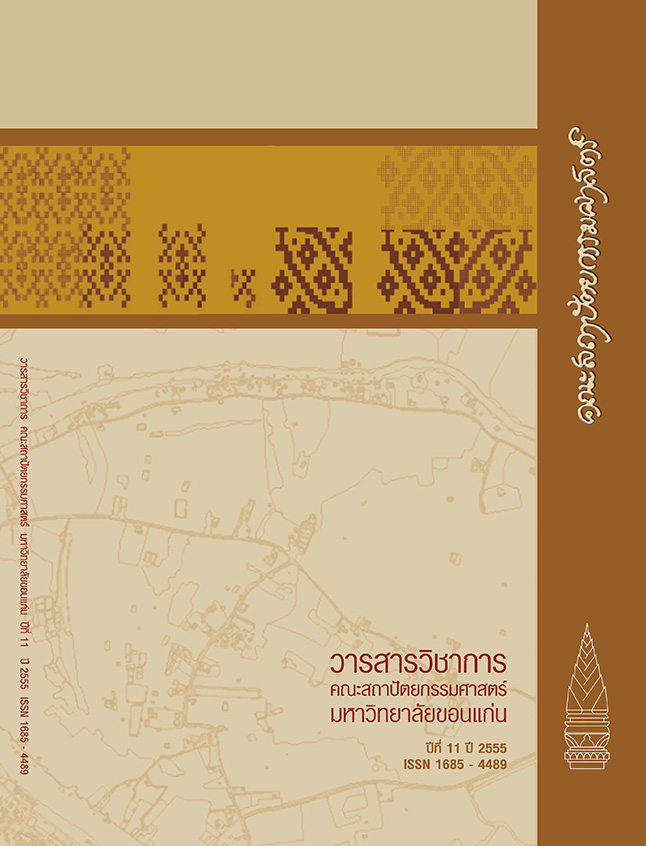การพัฒนาผลิตภัณฑ์ผ้าทอพื้นบ้านภาคใต้เพื่อเคหะสิ่งทอ : กรณีศึกษาผ้าทอนาหมื่นศรี ตำบลนาหมื่นศรี อำเภอนาโยง จังหวัดตรัง
คำสำคัญ:
ผ้าทอนาหมื่นศรี, การออกแบบลายผ้า, เคหะสิ่งทอ, Namuensri hand-woven, Pattern design, Home textileบทคัดย่อ
งานวิจัยนี้ได้ศึกษาวิจัยแนวทางการเพิ่มมูลค่าผ้าทอโดยการปรับใช้ประโยชน์ของผ้าทอใน ชีวิตประจำวันมากยิ่งขึ้น โดยเฉพาะอย่างยิ่งการนำผ้าทอไปใช้กับผลิตภัณฑ์เคหะสิ่งทอประเภท ต่างๆ ซึ่งประกอบด้วยการศึกษาเส้นใย การศึกษาการย้อมสีธรรมชาติ การศึกษาลวดลาย สีสัน กระบวนการทอผ้าและปัญหาต่างๆที่เป็นอุปสรรคต่อการพัฒนาผ้าทอของผ้าทอนาหมื่นศรี
การวิจัยในครั้งนี้พบว่าในการปั่นผสมเส้นใยนั้นปริมาณใยไหมอีรี่มีผลต่อความแข็งแรงและ การยืดตัวของเส้นด้าย เส้นใยที่ผสมใยไหมอีรี่ปริมาณมากกว่าจะมีความแข็งแรงและมีระยะการยืด ตัวของเส้นด้ายสูงกว่าเส้นด้ายที่มีคุณภาพมากที่สุดเหมาะที่จะเลือกใช้ในงานเคหะสิ่งทอระดับหัต กรรม คือเส้นด้ายที่ปั่นจากเส้นใยผสมระหว่างเส้นใยไหมอีรี่กับเส้นใยฝ้ายในอัตราผสม 75 : 25 รองลงมาคือเส้นด้ายผสมระหว่าง ใยไหมอีรี่กับใยพืช คือใยคล้า ใยขมิ้นและใยหมาก ในอัตราส่วน 75 :25 ผลการทดสอบความคงทนของสีย้อมพบว่าการย้อมสีจาก ใบสาบเสือ ใบเนียง ใบมังคุด และโกงกางนั้นมีความคงทนต่อสภาวะต่างๆได้ในระดับคุณภาพปานกลางถึงระดับคุณภาพดีมาก มีเพียงโกงกางเท่านั้นที่มีความคงทนของสีย้อมต่อการซักล้างในระดับ 1 มีการเปลี่ยนสีจาก สีนํ้าตาลเป็นสีแดง แสดงให้เห็นว่าด่างในสารซักล้างมีผลต่อสีย้อมจากโกงกาง
การศึกษาลายผ้าและการทอผ้านาหมื่นศรี เป็นแนวทางสำคัญในการเพิ่มมูลค่าจาก ภูมิปัญญาการทอดั้งเดิม เป็นการเรียนรู้อดีตและประยุกต์ใช้จนกระทั่งนำไปสู่การสร้างสรรค์ ลวดลายใหม่ๆ สร้างความแตกต่างจากรากฐานเดียวกันใน 4 แนวทางคือ 1)ออกแบบลายผ้าใหม่ 2) ออกแบบลายผ้าใหม่แล้วนำไปใช้ร่วมกับลายดั้งเดิม 3)การสร้างลายผ้าโดยการสลับตำแหน่งลาย และ 4) การปรับใช้โดยรักษาโครงสร้างลายเดิมไว้ จากการทดลองแนวทางที่ 4 นั้นพบว่าสามารถ รักษาดอกลายเดิมไว้ได้ครบถ้วนสมบูรณ์ ผลการวิจัยผืนผ้าที่ได้จากการทอในครั้งแรกพบว่าผ้าบาง จึงทำการแก้ไขโดยเปลี่ยนขนาดช่องฟืมให้เบอร์เล็กลงและเปลี่ยนด้ายยืนให้มีขนาดใหญ่ขึ้นหรือใช้ เส้นคู่ทำให้ได้ผืนผ้าทอเนื้อแน่นและแข็งแรงขึ้นเหมาะสำหรับการนำไปใช้กับผลิตภัณฑ์เคหะสิ่งทอ
LOCAL TEXTIES DEVELOPMENT IN SOUTHERNREGION OF THAILAND FOR HOME TEXTILE PRODUCTS : A CASE STUDY OF TAMBON NAMUENSRI, NAYONG DISTRICT, TRANG PROVINCE
This study examines the procedures in which economic value of hand-woven fabric is increased as it is adjusted to be more usable ineveryday life. For example, in the study of how hand-woven fabric is used to produce home textile, there are many applicable approaches and related topics. This research emphasizes on the study of fi ber, dying techniques, pattern, coloring, weaving process, and the problems hindering the improvement of hand-woven fabric in Namuensri.
The study results show that the quantity of eri silk affects that strength and fl exibility of fabric. The fabric mixed with higher quantity of eri fi bers is likely to have higher strength and fl exibility. The most effective fabric using in production of textile industry is mixture of eri and cotton with the proportion of 75 : 25. The second effective fabric is the mixture between eri and the fi ber of Canavalia rosea, curcuma, and betel nut with the proportion of 75 : 25. After the dying process, the textile needs to be test with the international standard for the durability of the colorant. These tests preserve the highest quality of natural colorant textile which enhances the effi ciency of textile production. According to the test of the persistent in natural pigment extracted from nature, the pigment from Siam weed leafs, mangosteen leafs, and mangrove leafs are all qualifi ed and durable except for the colorant from mangrove leafs that will change from brown to red after one step washing. This shows that alkali in washing substances affects the durability of mangrove extracted pigment. It is discovered that the study of Namuensri hand- woven fabric is a prominent way to preserve as much as revitalize local wisdom.
It is the reenactment of legacy from the past leading to the creation of new patterns which derive from the application of old wisdom in contemporary context. As different new patterns stemming from the same root, there are four techniques of inventing new patterns: 1) designing totally new patterns 2) designing new patterns before combining them with the old ones 3) designing new patterns by changing the detail or switching the position of existing patterns 4) the adjustment of existing patterns in which the main structures are maintained. For the last method, the detail from the original pattern can be kept in totality. However, in the fi rst weaving, it turned out that the fabric was too thin. Therefore the shaft frame was changed into the smaller size. Besides, the thicker warp yarn and the double yarn employed in the weaving process produce tighter and more enduring hand-woven fabric suitable for household use.
ดาวน์โหลด
รูปแบบการอ้างอิง
ฉบับ
ประเภทบทความ
สัญญาอนุญาต
ทัศนะและข้อคิดเห็นของบทความที่ปรากฏในวารสารฉบับนี้เป็นของผู้เขียนแต่ละท่าน ไม่ถือว่าเป็นทัศนะและความรับผิดชอบของกองบรรณาธิการ




